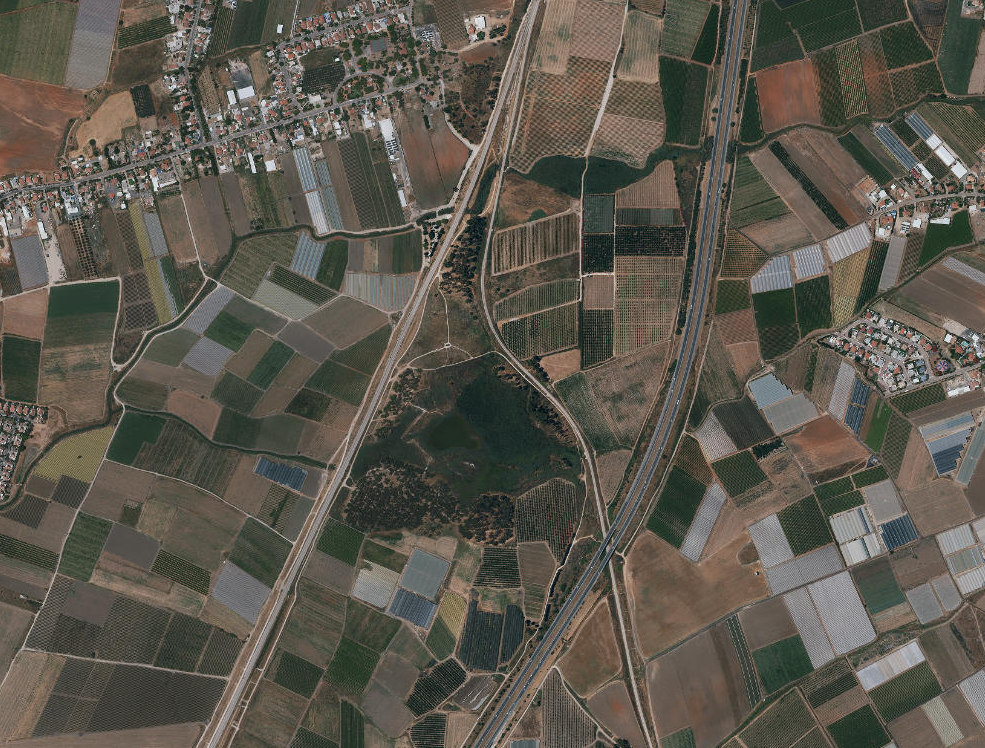 Khirbet al-Niʿana environs
Khirbet al-Niʿana environsclick on image to explore this site on a new tab in govmap.gov.il
| Transliterated Name | Language | Name |
|---|---|---|
| Khirbet al-Niʿana |

 Fig. 1
Fig. 1

 Fig. 1
Fig. 1

 Fig. 1
Fig. 1
| Stratum | Period | Date Range | Description |
|---|---|---|---|
| I | mid 7th century CE | ||
| II | mid-6th to beginning of 7th centuries CE | ||
| III | beginning to mid-6th century CE | ||
| IV | 5th century CE |
Taxel (2013:178-179) noted the following about archaeoseismic evidence in Khirbet al-Niʿana
Excavation of the western fringes of the inhabited area (the results of which were only preliminarily published) show no clear evidence for occupation after the mid-seventh century. According to the excavator (Torge, 2010)Taxel (2013:179) addedThe site was largely abandoned at the beginning of the Umayyad period and most of the masonry stones were plundered. The signs of destruction and burning may point to its destruction in the earthquake of 633 CE.Unfortunately, however, the basis for this dating was not provided in the report.
Although large parts of the site remained unexcavated, and many details regarding some of the excavations await more detailed publication, the history of Khirbet al-Niʿana at the beginning of the Early Islamic period can be tentatively reconstructed. The results of the above-mentioned excavations indicate that domestic and industrial activity continued, with little change, at least until the second half of the seventh century. This conclusion, which is based on the published ceramic and numismatic finds, contradicts Torge’s suggestion (above) concerning the destruction and almost complete abandonment of the settlement in 633 C.E. However, it seems quite clear that certain parts of the site were not occupied after the seventh century; secure evidence for eighth to ninth/tenth century activity has thus far only been attested at the southeastern fringes. It is therefore possible that around the late seventh/early eighth century, the settlement was reduced in size or the core of the inhabited area was moved to another location that has not yet been excavated.
| Effect | Location | Image(s) | Description |
|---|---|---|---|
|
Area B (Squares 30-36)
 Fig. 1
Fig. 1General Plan Torge (2010) |
Torge (2010)
reports a thick layer of collapse, containing large ashlar stones, pieces of roof tiles, sections of a ceramic pipe and numerous pottery fragmentson the floors of the buildingsin 5th century CE stratum IV in Area B (Squares 30-36) |

 Earthquake Archeological Effects (EAE)
Earthquake Archeological Effects (EAE)| Effect | Location | Image(s) | Description | Intensity |
|---|---|---|---|---|
|
Area B (Squares 30-36)
 Fig. 1
Fig. 1General Plan Torge (2010) |
Torge (2010)
reports a thick layer of collapse, containing large ashlar stones, pieces of roof tiles, sections of a ceramic pipe and numerous pottery fragmentson the floors of the buildingsin 5th century CE stratum IV in Area B (Squares 30-36) |
|
Berman, A.
2007 The Coins from Khirbat el-Niʿana. ʿAtiqot 57: 155–
62.
Sion, O.2007 The Excavations at Khirbat el-Niʿana. ʿAtiqot 57:
29*–49* (Hebrew), 166–67 (English summary).
Sion, O., and de Vincenz, A. 2007 The Pottery Assemblages from Khirbat el-Niʿana. ʿAtiqot 57: 21–52.
Sussman, V. 2007 The Clay Oil Lamps from Khirbat el-Niʿana. ʿAtiqot 57: 53–72.
Taxel, I. (2013). "Rural Settlement Processes in Central Palestine, ca. 640–800 c.e.: The Ramla-Yavneh Region as a Case Study."
Bulletin of the American Schools of Oriental Research 369: 157–199.
Torge, H. (2010). Khirbat el-Niʿana.
Ḥadashot Arkheologiyot – Excavations and Surveys in Israel 122.
Tsioni, G. 2008 A Salvage Excavation at Khirbet Niʿana. Contract Archaeology Reports 3: 33–66 (Hebrew).